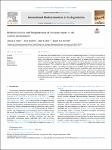Biodeterioration and bioprotection of concrete assets in the coastal environment
| dc.contributor.author | Bone, JR | |
| dc.contributor.author | Stafford, R | |
| dc.contributor.author | Hall, AE | |
| dc.contributor.author | Herbert, RJH | |
| dc.date.accessioned | 2023-12-18T11:42:41Z | |
| dc.date.available | 2023-12-18T11:42:41Z | |
| dc.date.issued | 2022-11 | |
| dc.identifier.issn | 0964-8305 | |
| dc.identifier.other | 105507 | |
| dc.identifier.uri | https://pearl.plymouth.ac.uk/handle/10026.1/21804 | |
| dc.description.abstract |
The deleterious effects (biodeterioration) and the protective benefits (bioprotection) of biological colonisation on manmade structures have long been debated. Lichens, biofilms, algae, bivalves and gastropods contribute both directly and indirectly to damaging substrata in the coastal zone which can enhance abiotic erosive forces that exploit biologically induced superficial damage. There is mounting evidence that these same species may also provide protective benefits. This debate often impacts approaches to managing fouling on concrete assets in the coastal environment. The net benefit or detriment a species or assemblage has on a structure is spatially and temporally dynamic and subject to the influence of various abiotic and biotic factors at different scales. However, the net outcome may be more pronounced under different contexts, particularly under warming and ocean acidifying climate change scenarios which is where further research should focus. Additionally, as bioprotection represents a potentially valuable ecosystem service, it supports the argument for increasing and improving habitat availability and biodiversity on artificial coastal structures via ecological enhancement. Quantifying bioprotection in useful metrics, such as monetary value or time added to serviceable life, would help demonstrate the benefits of bioprotective species in a meaningful way. | |
| dc.format.extent | 105507-105507 | |
| dc.language | en | |
| dc.publisher | Elsevier BV | |
| dc.subject | 3107 Microbiology | |
| dc.subject | 31 Biological Sciences | |
| dc.subject | 3106 Industrial Biotechnology | |
| dc.title | Biodeterioration and bioprotection of concrete assets in the coastal environment | |
| dc.type | journal-article | |
| dc.type | Review | |
| plymouth.volume | 175 | |
| plymouth.publication-status | Published | |
| plymouth.journal | International Biodeterioration & Biodegradation | |
| dc.identifier.doi | 10.1016/j.ibiod.2022.105507 | |
| plymouth.organisational-group | |Plymouth | |
| plymouth.organisational-group | |Plymouth|Faculty of Science and Engineering | |
| plymouth.organisational-group | |Plymouth|Faculty of Science and Engineering|School of Biological and Marine Sciences | |
| plymouth.organisational-group | |Plymouth|REF 2021 Researchers by UoA | |
| plymouth.organisational-group | |Plymouth|Users by role | |
| plymouth.organisational-group | |Plymouth|Users by role|Academics | |
| plymouth.organisational-group | |Plymouth|REF 2021 Researchers by UoA|UoA07 Earth Systems and Environmental Sciences | |
| plymouth.organisational-group | |Plymouth|REF 2028 Researchers by UoA | |
| plymouth.organisational-group | |Plymouth|REF 2028 Researchers by UoA|UoA07 Earth Systems and Environmental Sciences | |
| dcterms.dateAccepted | 2023-09-28 | |
| dc.date.updated | 2023-12-18T11:42:40Z | |
| dc.rights.embargodate | 2023-12-19 | |
| rioxxterms.versionofrecord | 10.1016/j.ibiod.2022.105507 |


